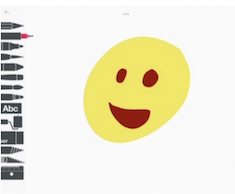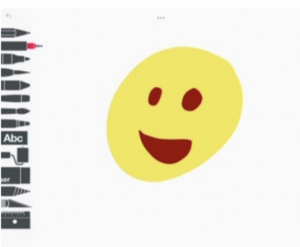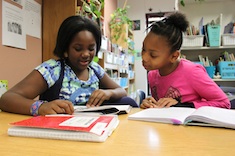Alex and Brian were sitting near each other as they worked on creating emojis to use in a blog post when I walked by. Alex found it easy to get words on paper and routinely used words and images in her writing. She was not afraid to take risks or try new things when composing digitally. Brian, on the other hand, was not as confident in his writing or artistic abilities.
Brian (leaning over and looking at Alex’s emoji): How did you get it to look so good?
Alex: What?
Brian: You got the yellow color all the way in.
Alex: I used this. It looks like spray. (She pointed to the spray tool in the app she was using.) You can add more, like colors.
Brian: I wish I did that.
Brian (looking at me): Can I do that to mine?
Me: Of course! Give it a try.
Alex then leaned over and showed him where to find the tool in his app and how to use it. Brian went from being disappointed in his first drawing to being happy and satisfied after starting over with the spray tool.
Brian’s original drawing.
Brian’s image after he learned to use the spray tool.
This conversation isn’t memorable because Brian learned how to make his emoji look better. What stands out to me is how willing Brian was to ask Alex for help. In our classroom, we begin the year laying the foundation that we can all learn from each other. In this instance, Alex was the expert and could teach something to Brian. At another time, Brian became the expert when he shared his graphic novel and showed others how to make his signature character.
The Importance of Talk in Writing Workshop
If you were to walk into a writing workshop in my classroom, you would notice several things right away. First, children are sprawled all over. Some are sitting at their table with another writer, some are sitting under a desk by themselves. You would see children lying on their bellies across the carpet, iPads, books, paper, and pencils nearby for the work they are doing.
Second, and just as important, it is not quiet. A long time ago, I believed that writers needed a quiet space to work, that if there was going to be any kind of talk, it needed to be about their writing. It wasn’t until I learned more about children and writing that I came to understand that writing is a social process. When I paused and took the time to listen and watch, I came to realize that there is important literacy work being done through their talk, even when they seem to be “off topic.” When we allow students to talk while they compose, we give them the opportunity to create new understandings together, build relationships, and validate each other. This understanding has required a change in my practice.
Be Curious
Instead of shutting down what appears to be silly, off-task behavior, I pause and listen. I’ve learned to listen in with a sense of curiosity, asking myself, What’s happening here? This mindset allows me to enter the world of a young writer. At one table, Emily and Maggie were laughing over an outrageous story they were making up about LeBron James, who went to Maggie’s birthday party to play basketball with the partygoers. Of course, LeBron James wasn’t at Maggie’s birthday party, but the girls’ storytelling gave Maggie ingredients to elaborate in her story, adding details and voice. As I watched them, I could see that they were both still writing, stopping only to embellish this imaginative story of playing basketball with LeBron James, one of Maggie’s heroes.
Together they were creating a story, building off of each other’s ideas. This storytelling then became woven into Maggie’s book. We are social creatures. We want to connect with others. That’s exactly what the girls were doing. It was evident they were enjoying this exchange as they went back and forth. They would laugh, write a little bit more, tell more of the story, write some more. Together, the girls created an imaginary story world that would come up again in Maggie’s writing.
Trust Students to Be Writers
The talk between the teacher and the student is very important. When I sit down to talk to kids about their writing, I talk to them writer to writer. I mention something that I notice about their work. It’s as simple as something like, “Oh, I notice you used really dark colors here.” This kind of opening invites students to begin a dialogue about their decisions as writers. I learn a lot about their process by engaging in these conversations. More importantly, students know that I value what they are doing as something meaningful and purposeful.
Another strategy I use is to ask questions like, “How are you going to show this?” This is a deliberate move to give kids space to think about and then articulate how they will make meaning with the tools they have. It allows a richness and depth to show how they are working. They talk and I listen, which positions them as competent writers who can make decisions about their writing. Having these kinds of conversations with me gives students practice talking about their writing as a writer. It isn’t long before they’re having these kinds of conversations among themselves.
I’ve come to learn just how important it is to pause and listen. Kids need the time and space for conversation as they compose. Taking this stance ensures that everyone is positioned as knowledgeable and as a contributing member of our learning community. We are a community that learns together, not individually, and our learning is reflected in future thinking and writing.








